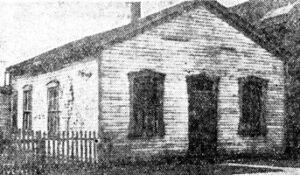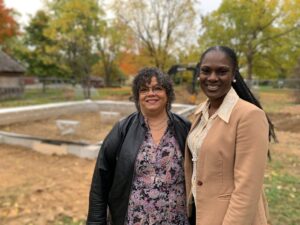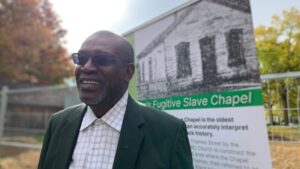
It’s been fifteen years since London’s Fugitive Slave Chapel was set for demolition. Now, organizers behind its restoration say they can finally breathe a sigh of relief. At a symbolic groundbreaking ceremony on last morning, $150,000 in federal funding was announced — helping to reach the fundraising campaign’s original goal of $300,000 — and securing a path for the chapel to move to its new home at Fanshawe Pioneer Village in November.
“It’s taken longer than we thought, but it’s great that we’re at this point right now. We’re excited to be here and excited to have been able to raise the money,” said Carl Cadogan, chair of the London Black History co-ordinating committee.
The chapel, built in 1848 by the African Methodist Episcopal Church, served as a gathering and worship space for London’s Black community until 1869. It also became a refuge for many who came to Canada through the Underground Railroad escaping enslavement in the U.S.
Seeing the chapel’s foundation in place at Fanshawe Pioneer Village was significant for Alexandra Kane, a member of the chapel restoration steering committee and Black Lives Matter London.
“It just means all the hard work, all the meetings, all of the visits, all of the hustle and bustle has come to fruition. This is the first step in the journey of this church with regards to its


permanency.” she said. “I think this is a huge move for people to be able to sit in our history and to respect and revere our ancestors.”
Having a physical chapel in place lifts the history out of the books, she said. “It’s more of an immersive experience to be able to feel history, to smell it, to touch it.” For advocates working to save the chapel, the building is more than a symbol of history.
“Saving the Fugitive Slave Chapel and preserving it depicts our history, our contribution to the Canadian history, to the Black history of Canada, but more importantly, the London community,” said Nikisha Evans, president of the Congress of Black Women’s London chapter and on the chapel steering committee.
For Christina Lord, it is a symbol of how many generations Black people have been part of the core community in London. Once the permits are in place, the chapel is set to be relocated in November. It will be “wrapped”
for the winter – and restoration work will begin in the spring, Lord said. “It’s very exciting.”
The federal funding brings the project “close to the top” but more donations may be needed to cover inflation of construction materials and the education portion of the project, Lord said.
The chapel was first moved in 2014 from Thames Street to the Grey Street location and was donated to the London and Middlesex Heritage Museum in 2021.
The chapel will be used to educate students and the wider community, but its use won’t end there, Evans said.
“We still have more steps to do,” she said. “Come out and learn about it and research so that you can better educate yourself about the Black community.”


